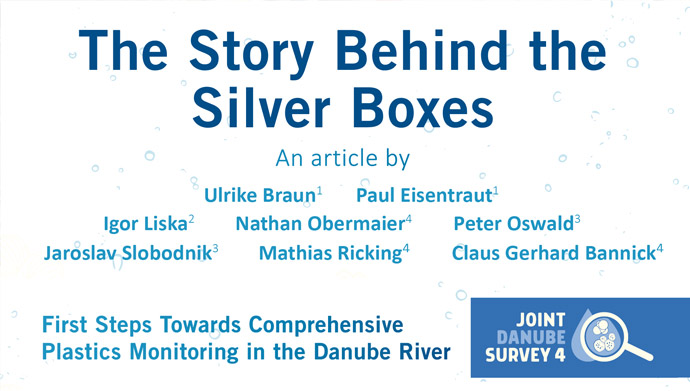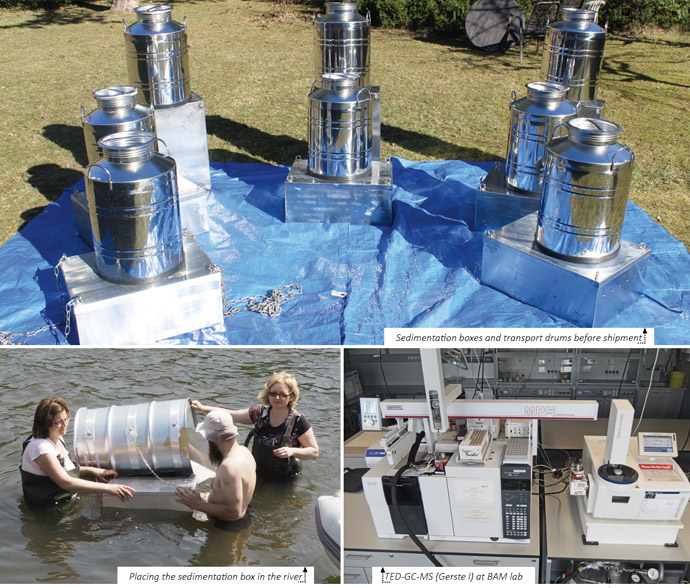Danube Watch 3/2019 - The Story Behind the Silver Boxes

With the adoption of the EU Plastics Strategy in 2018, the subject of plastics and their presence in various environmental media has once again become the focus of public attention. The topic is also high on the agenda in the wider, international context. Despite the UN, OECD, WHO, G7, G20 and others dealing with this topic, it should be noted that there are currently no harmonised testing methods for plastics in environmental matrices. An international group of experts is currently endeavouring to address this comprehensively in the standardisation committee ISO TC 61. In the background of all these activities is the need to reduce the input of plastics into the oceans, which represent a final sink for many anthropogenic substances and materials.
Considering the lack of standardised methodologies, it is not surprising that only the Joint Danube Survey 4 (JDS4) in 2019 provided the opportunity to examine the presence of plastics, and more specifically microplastics (MP), in the Danube River in a comprehensive way. The idea of such a survey goes back to Joachim Heidemeier from the German Federal Environment Agency (UBA), who regrettably died far too early and is now unable to look at the first results.
Like most of the investigations carried out within the JDS context, this first plastics screening was a joint effort of many participants. First and foremost, of the JDS national teams who took the samples on site. The handling of the bulky plastics samplers, ensuring a high quality and comparability of the final results was not an easy task. Large quantities of suspended particulate matter (SPM) from the Danube region had to be brought to UBA Berlin under controlled conditions for further sample treatment. This required a great degree of organisation, which was handled by the Environmental Institute (EI) in Kos, Slovakia. The actual detection of plastics was carried out by the German Federal Institute for Material Testing and Research (BAM) in Berlin. There are basically two possibilities for the examination of plastics, which return either particle numbers and sizes or the total content of plastics. To reply to questions addressing effects and/or ageing status of plastics, it is useful to investigate particle numbers and sizes and characterise their specific properties. In order to get a first impression on the occurrence of plastics and a first assessment of their sources, the determination of their total contents is more suitable. All of these examination analyses are carried out with a rather new analytical method.
In the JDS4-Plastic-Screening, the BAM used the Thermal-Extraction Desorption - Gas Chromatography - Mass Spectrometry (TED-GC-MS) as a fast, integral analytical technique providing information about the total content of MP. In this analysis, the sample is first pyrolysed to 600°C in a nitrogen atmosphere and then an excerpt of the pyrolysis gases is collected on a solid phase adsorber. Afterwards, the decomposition gases are desorbed and measured in a GC-MS system. Characteristic pyrolysis products of each polymer can be used to identify the polymer type and determine the mass contents in the sample. This method is already well established for the analysis of MP in water filtrate samples.
Similar to the analytical methods, there are also many possibilities for sampling. To get a first impression of the occurrence of MP, sedimentation boxes were used which were deployed in the water body for 14 days and retained SPM from the water. The design of the sedimentation box was already presented in Danube Watch 2/19 (Hohenblum, 2019). The model used in the JDS4 corresponds to the model that is applied by the German Environmental Specimen Bank within the national screening programme.

Another important aspect was the sample preparation. The trapped suspended matter (SPM) from the sedimentation boxes was brought to Berlin as total samples and had to be prepared for further investigations. This included filtration through sieves on which the solid particles, including plastics, were retained and subsequently dried. For some samples, it was foreseeable that a density separation would have to be carried out.
The sampling along the Danube River was carried out from June until October 2019 in nine Danube riparian states - Germany, Austria, the Czech Republic, Slovakia, Hungary, Serbia, Bulgaria, Romania and Ukraine. We would like to take this opportunity to thank the JDS4 National Coordinators and experts responsible for MP screening in all these countries. Without their commitment and financial contribution, MP sampling within the JDS4 would not have been possible.
A model of mixed financing was used for funding the MP Screening within the JDS4. The transport of the samples was handled by the ICPDR, while UBA and BAM contributed to the preparation and overall coordination of the survey and analyses. A considerable amount of the costs was covered by the German Ministry of Research and Education. One of the immediate results of the JDS4 MP screening is that this project serves to bring together a group of key research institutes from the Danube Region that are currently applying for a major EU-funded Horizon 2020 project. The call targets, among others, MP sources, pathways and sinks in different geographical regions and the preliminary investigations carried out in the JDS4 became a part of the proposal. If successful, this new research project will focus on land-based plastics inputs into the environment, their transport mechanisms and their contribution to marine pollution. In this respect, the Danube and Black Sea ecosystem is ideally suited for investigating these issues. A consortium led by the UBA is currently finalising the proposal. However, the decision of the European Commission remains to be seen.
1 - German Federal Institute for Material Testing and Research (BAM), Berlin, Germany. 2 - International Commission for the Protection of the Danube River (ICPDR). 3 - Environmental Institute (EI), Kos, Slovakia. 4 - German Federal Environment Agency (UBA), Berlin, Germany.






